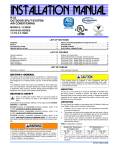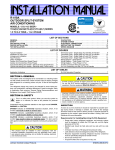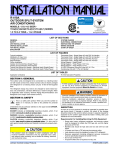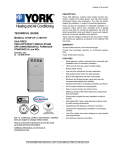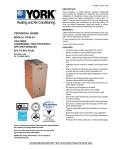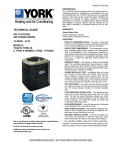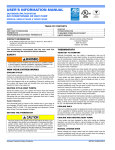Download York TCGD18 THRU 60 Installation manual
Transcript
INSTALLATION MANUAL R-22 OUTDOOR SPLIT-SYSTEM AIR CONDITIONING MODELS: 13 SEER TCGD12 - 60 & GCGD12 - 60 SERIES 1 TO 5 TONS LISTED ISO 9001 Certified Quality Management System LIST OF SECTIONS GENERAL . . . . . . . . . . . . . . . . . . . . . . . . . . . . . . . . . . . . . . . . . . . . . . 1 SAFETY . . . . . . . . . . . . . . . . . . . . . . . . . . . . . . . . . . . . . . . . . . . . . . . . 1 UNIT INSTALLATION . . . . . . . . . . . . . . . . . . . . . . . . . . . . . . . . . . . . . 2 ORIFICE INSTALLATION . . . . . . . . . . . . . . . . . . . . . . . . . . . . . . . . . . 4 INSTALLATIONS REQUIRING AN ADD-ON TXV KIT . . . . . . . . . . . .4 EVACUATION . . . . . . . . . . . . . . . . . . . . . . . . . . . . . . . . . . . . . . . . . . .5 SYSTEM CHARGE . . . . . . . . . . . . . . . . . . . . . . . . . . . . . . . . . . . . . . .5 ELECTRICAL CONNECTIONS . . . . . . . . . . . . . . . . . . . . . . . . . . . . . .6 LIST OF FIGURES Typical Installation . . . . . . . . . . . . . . . . . . . . . . . . . . . . . . . . . . . . . . . . 2 Installation of Vapor Line . . . . . . . . . . . . . . . . . . . . . . . . . . . . . . . . . . . 3 Underground Installation . . . . . . . . . . . . . . . . . . . . . . . . . . . . . . . . . . . 3 Heat Protection . . . . . . . . . . . . . . . . . . . . . . . . . . . . . . . . . . . . . . . . . . 4 Orifice Installation . . . . . . . . . . . . . . . . . . . . . . . . . . . . . . . . . . . . . . . . .4 Outdoor Unit Control Box . . . . . . . . . . . . . . . . . . . . . . . . . . . . . . . . . . .6 Typical Field Wiring (Air Handler / Electrical Heat) . . . . . . . . . . . . . . . .6 Thermostat Chart . . . . . . . . . . . . . . . . . . . . . . . . . . . . . . . . . . . . . . . . .7 LIST OF TABLES Application Limitations . . . . . . . . . . . . . . . . . . . . . . . . . . . . . . . . . . . . . 1 R-22 Saturated Properties . . . . . . . . . . . . . . . . . . . . . . . . . . . . . . . . . 5 SECTION I: GENERAL The outdoor units are designed to be connected to a matching indoor coil with sweat connect lines. Sweat connect units are factory charged with refrigerant for a matching indoor coil plus 15 feet of field supplied lines. The refrigerant charge may need to be changed for some indoor-outdoor unit combinations, elevation differences or total line lengths. Refer to Application Data covering “General Piping Recommendations and Refrigerant Line Length” (Part Number 247077). SECTION II: SAFETY This is a safety alert symbol. When you see this symbol on labels or in manuals, be alert to the potential for personal injury. Understand and pay particular attention to the signal words DANGER, WARNING, or CAUTION. DANGER indicates an imminently hazardous situation, which, if not avoided, will result in death or serious injury. WARNING indicates a potentially hazardous situation, which, if not avoided, could result in death or serious injury. CAUTION indicates a potentially hazardous situation, which, if not avoided may result in minor or moderate injury. It is also used to alert against unsafe practices and hazards involving only property damage. This product must be installed in strict compliance with the enclosed installation instructions and any applicable local, state, and national codes including, but not limited to building, electrical, and mechanical codes. INSPECTION As soon as a unit is received, it should be inspected for possible damage during transit. If damage is evident, the extent of the damage should be noted on the carrier’s delivery receipt. A separate request for inspection by the carrier’s agent should be made in writing. See Local Distributor for more information. LIMITATIONS The unit should be installed in accordance with all National, State and Local Safety Codes and the limitations listed below: 1. Limitations for the indoor unit, coil, and appropriate accessories must also be observed. 2. The outdoor unit must not be installed with any duct work in the air stream. The outdoor fan is the propeller type and is not designed to operate against any additional external static pressure. 3. The maximum and minimum conditions for operation must be observed to ensure a system that will give maximum performance with minimum service. TABLE 1: Application Limitations Improper installation may create a condition where the operation of the product could cause personal injury or property damage. Improper installation, adjustment, alteration, service or maintenance can cause injury or property damage. Refer to this manual for assistance or for additional information, consult a qualified contractor, installer or service agency. Ambient Air Temperature on Outdoor Coil 4. Air Temperature on Indoor Coil Min. DB Max. DB Min. WB Max. WB 50 °F 115 °F 57 °F 72 °F The unit should not be operated at outdoor temperatures below 50° F without an approved low ambient operation accessory kit installed. 290982-UIM-B-0807 290982-UIM-B-0807 SECTION III: UNIT INSTALLATION ADD-ON REPLACEMENT/RETROFIT LOCATION The following steps should be performed in order to insure proper system operation and performance. Before starting the installation, select and check the suitability of the location for both the indoor and outdoor unit. Observe all limitations and clearance requirements. The outdoor unit must have sufficient clearance for air entrance to the condenser coil, air discharge, and service access. See Figure 1. NOTE: For multiple unit installations, units must be spaced a minimum of 18 inches apart (coil face to coil face). If the unit is to be installed on a hot sun exposed roof or a black-topped ground area, the unit should be raised sufficiently above the roof or ground to avoid taking the accumulated layer of hot air into the outdoor unit. 1. Change-out the indoor coil, if required, to an approved R-22 coil/ condensing unit combination with the appropriate metering device. 2. If the outdoor unit is being replaced due to a compressor burnout, then installation of a 100% activated alumina suction-line filter drier in the suction-line is required, in addition to the factory installed liquid-line drier. Operate the system for 10 hours. Monitor the suction drier pressure drop. If the pressure drop exceeds 3 psig, replace both the suction-line and liquid-line driers. After a total of 10 hours run time where the suction-line pressure drop has not exceeded 3 psig, replace the liquid line drier, and remove the suction-line drier. Never leave a suction-line drier in the system longer than 50 hours of run time. Provide an adequate structural support. 60” OVERHEAD CLEARANCE MINIMUM 18” SERVICE ACCESS CLEARANCE ON ONE SIDE THERMOSTAT WEATHERPROOF DISCONNECT SWITCH NEC CLASS 1 WIRING 6” CLEARANCE AROUND PERIMETER TO FURNACE OR AIR HANDLER TERMINAL BLOCK NEC CLASS 2 WIRING TO INDOOR COIL NOTE: ALL OUTDOOR WIRING MUST BE WEATHERPROOF. CONTROL ACCESS PANEL SEAL OPENING(S) WITH PERMAGUM OR EQUIVALENT FIGURE 1: Typical Installation GROUND INSTALLATION ROOF INSTALLATION The unit should be installed on a solid base that is 2” above grade and will not shift or settle, causing strain on the refrigerant lines and possible leaks. Maintain the clearances shown in Figure 1 and install the unit in a level position. The base pad should not come in contact with the foundation or side of the structure because sound may be transmitted to the residence. When installing units on a roof, the structure must be capable of supporting the total weight of the unit, including a pad, lintels, rails, etc., which should be used to minimize the transmission of sound or vibration into the conditioned space. The length of the refrigerant tubing between the outdoor unit and indoor coil should be as short as possible to avoid capacity and efficiency losses. Excessive spacing of the outdoor unit from the home can result in the refrigerant lines being restricted by trampling or being punctured by lawn mowers. Locate the outdoor unit away from bedroom windows or other rooms where sound might be objectionable. The air conditioning unit’s copper spun filter/dryer is located on the liquid line. Adverse effects of snow or sleet accumulating on the outdoor coil can be eliminated by placing the outdoor unit where the prevailing wind does not blow across the unit. Trees, shrubs, corners of buildings, and fences standing off from the coil can reduce capacity loss due to wind chill effect. Provide ample clearance from shrubs to allow adequate air to pass across the outdoor coil without leaves or branches being pulled into the coil. 2 LIQUID LINE FILTER-DRIER NOTE: Replacements for the liquid line drier must be exactly the same as marked on the original factory drier. See Source 1 for O.E.M. replacement driers. Failure to do so or using a substitute drier or a granular type may result in damage to the equipment. R-22 Filter-Drier Source 1 Part No. Apply with Models TCGD / GCGD S1-02922156000 1 to 3 Tons S1-02922157000 3.5 to 5 Tons Unitary Products Group 290982-UIM-B-0807 PIPING CONNECTIONS TO OUTDOOR UNIT TO INDOOR COIL The outdoor condensing unit must be connected to the indoor evaporator coil using field supplied refrigerant grade (ACR) copper tubing that is internally clean and dry. Units should be installed only with the tubing sizes for approved system combinations as specified in tabular data sheet. The charge given is applicable for total tubing lengths up to 15 feet. See Application Data Part Number 247077 for installing tubing of longer lengths and elevation differences. Liquid Line Insulated Vapor Line Cap PVC Conduit NOTE: Using a larger than specified line size could result in oil return problems. Using too small a line will result in loss of capacity and other problems caused by insufficient refrigerant flow. Slope horizontal vapor lines at least 1" every 20 feet toward the outdoor unit to facilitate proper oil return. FIGURE 3: Underground Installation PRECAUTIONS DURING LINE INSTALLATION PRECAUTIONS DURING BRAZING OF LINES 1. Install the lines with as few bends as possible. Care must be taken not to damage the couplings or kink the tubing. Use clean hard drawn copper tubing where no appreciable amount of bending around obstruction is necessary. If soft copper must be used, care must be taken to avoid sharp bends which may cause a restriction. 2. The lines should be installed so that they will not obstruct service access to the coil, air handling system, or filter. All outdoor unit and evaporator coil connections are copper-to-copper and should be brazed with a phosphorous-copper alloy material such as Silfos-5 or equivalent. DO NOT use soft solder. The outdoor units have reusable service valves on both the liquid and vapor connections. The total system refrigerant charge is retained within the outdoor unit during shipping and installation. The reusable service valves are provided to evacuate and charge per this instruction. 3. Care must also be taken to isolate the refrigerant lines to minimize noise transmission from the equipment to the structure. Serious service problems can be avoided by taking adequate precautions to assure an internally clean and dry system. 4. The vapor line must be insulated with a minimum of 1/2" foam rubber insulation (Armaflex or equivalent). Liquid lines that will be exposed to direct sunlight, high temperatures, or excessive humidity must also be insulated. 5. Tape and suspend the refrigerant lines as shown. DO NOT allow tube metal-to-metal contact. See Figure 2. 6. Use PVC piping as a conduit for all underground installations as shown in Figure 3. Buried lines should be kept as short as possible to minimize the build up of liquid refrigerant in the vapor line during long periods of shutdown 7. Pack fiberglass insulation and a sealing material such as permagum around refrigerant lines where they penetrate a wall to reduce vibration and to retain some flexibility. 8. For systems with total line length exceeding 50 feet, see APPLICATION DATA and worksheet "General Piping Recommendations and Refrigerant Line Length" for vapor and liquid line sizing, calibration of liquid line pressure loss or gain, determination of vapor line velocity, elevation limitations, orifice connections, system charging, traps, etc. Dry nitrogen should always be supplied through the tubing while it is being brazed, because the temperature required is high enough to cause oxidation of the copper unless an inert atmosphere is provided. The flow of dry nitrogen should continue until the joint has cooled. Always use a pressure regulator and safety valve to insure that only low pressure dry nitrogen is introduced into the tubing. Only a small flow is necessary to displace air and prevent oxidation. PRECAUTIONS DURING BRAZING SERVICE VALVE Precautions should be taken to prevent heat damage to service valve by wrapping a wet rag around it as shown in Figure 4. Also, protect all painted surfaces, insulation, and plastic base during brazing. After brazing, cool joint with wet rag. This is not a backseating valve. The service access port has a valve core. Opening or closing valve does not close service access port. If the valve stem is backed out past the chamfered retaining wall, the O-ring can be damaged causing leakage or system pressure could force the valve stem out of the valve body possibly causing personal injury. Sheet Metal Hanger Liquid Line Incorrect Tape Correct Insulated Vapor Line Valve can be opened by removing the plunger cap and fully inserting a hex wrench into the stem and backing out counter-clockwise until valve stem just touches the chamfered retaining wall. Connect the refrigerant lines using the following procedure: 1. Remove the cap and Schrader core from both the liquid and vapor service valve service ports at the outdoor unit. Connect low pressure nitrogen to the liquid line service port. 2. Braze the liquid line to the liquid valve at the outdoor unit. Be sure to wrap the valve body with a wet rag. Allow the nitrogen to continue flowing. 3. Carefully remove the plugs from the evaporator liquid and vapor connections at the indoor coil. FIGURE 2: Installation of Vapor Line Unitary Products Group 3 290982-UIM-B-0807 Never attempt to repair any brazed connections while the system is under pressure. Personal injury could result. See "System Charge” section for checking and recording system charge. Supplied with the outdoor unit is a Schrader Valve Core and Orifice for highest sales volume indoor coil. The valve core must be installed in equalizer fitting of the indoor coil. SECTION IV: ORIFICE INSTALLATION FIGURE 4: Heat Protection Failure to install Schrader Valve Core on orifice applications could result in total refrigerant loss of the system! Install Schrader Valve Core as follows: Do not install any coil in a furnace which is to be operated during the heating season without attaching the refrigerant lines to the coil. The coil is under 30 to 35 psig inert gas pressure which must be released to prevent excessive pressure build-up and possible coil damage. 4. Braze the liquid line to the evaporator liquid connection. Nitrogen should be flowing through the evaporator coil. 5. Slide the grommet away from the vapor connection at the indoor coil. Braze the vapor line to the evaporator vapor connection. After the connection has cooled, slide the grommet back into original position. 6. Protect the vapor valve with a wet rag and braze the vapor line connection to the outdoor unit. The nitrogen flow should be exiting the system from the vapor service port connection. After this connection has cooled, remove the nitrogen source from the liquid fitting service port. 7. Replace the Schrader core in the liquid and vapor valves. 8. Go to “SECTION V” or “SECTION IV” for orifice or TXV installation depending on application. 9. Leak test all refrigerant piping connections including the service port flare caps to be sure they are leak tight. DO NOT OVERTIGHTEN (between 40 and 60 inch - lbs. maximum). 1. Slide indoor coil out of cabinet far enough to gain access to equalizer fitting on the suction line. 2. After holding charge is completely discharged remove black plastic cap on equalizer fitting. 3. Install Schrader Valve Core supplied with the outdoor unit into equalizer fitting using a valve core tool. 4. Loosen and remove the liquid line fitting from the orifice distributor assembly. Note that the fitting has right hand threads. 5. Install proper size orifice supplied with outdoor unit. Refer to supplied Tabular Data Sheet for specific orifice size and indoor coil match up. 6. After orifice is installed reinstall the liquid line to the top of the orifice distributor assembly. Hand tighten and turn an additional 1/8 turn to seal. Do not over tighten fittings. 7. Leak test system. 8. Replace black plastic cap on equalizer fitting. 9. Slide indoor coil back into cabinet. LIQUID LINE SWIVEL COUPLING (This fitting is a right-hand thread, turn counter-clockwise to remove) NOTE: Line set and indoor coil can be pressurized to 250 psig with dry nitrogen and leak tested with a bubble type leak detector. Then release the nitrogen charge. NOTE: Do not use the system refrigerant in the outdoor unit to purge or leak test. 10. Evacuate the vapor line, evaporator, and liquid line to 500 microns or less. ORIFICE 11. Replace cap on service ports. Do not remove the flare caps from the service ports except when necessary for servicing the system. Do not connect manifold gauges unless trouble is suspected. Approximately 3/4 ounce of refrigerant will be lost each time a standard manifold gauge is connected. DISTRIBUTOR FIGURE 5: Orifice Installation SECTION V: INSTALLATIONS REQUIRING AN ADD-ON TXV KIT 12. Release the refrigerant charge into the system. Open both the liquid and vapor valves by removing the plunger cap and with an allen wrench back out counter-clockwise until valve stem just touches the chamfered retaining wall. See Page 3 "PRECAUTIONS DURING BRAZING SERVICE VALVE". For installations requiring a TXV kit, refer to the Installation Instructions accompanying the TXV kit. 13. Replace plunger cap finger tight, then tighten an additional 1/12 turn (1/2 hex flat). Cap must be replaced to prevent leaks. Schrader valve core MUST NOT be installed with TXV installation. Poor system performance or system failure could result. 4 Unitary Products Group 290982-UIM-B-0807 SECTION VI: EVACUATION It will be necessary to evacuate the system to 500 microns or less. If a leak is suspected, leak test with dry nitrogen to locate the leak. Repair the leak and test again. To verify that the system has no leaks, simply close the valve to the vacuum pump suction to isolate the pump and hold the system under vacuum. Watch the micron gauge for a few minutes. If the micron gauge indicates a steady and continuous rise, it’s an indication of a leak. If the gauge shows a rise, then levels off after a few minutes and remains fairly constant, it’s an indication that the system is leak free but still contains moisture and may require further evacuation if the reading is above 500 microns. If a calibrated charging cylinder or accurate weighing device is available, add refrigerant accordingly. Otherwise, model-specific charging charts are provided on the access panel of the unit. SUPERHEAT CHARGING METHOD PISTON INDOOR 1. 2. 3. SECTION VII: SYSTEM CHARGE 4. The factory charge in the outdoor unit includes enough charge for the unit, a 15 ft. line set, and the smallest indoor coil match-up. Some indoor coil matches may require additional charge. See tabular data sheet provided in unit literature packet for charge requirements. 5. 6. Do not leave the system open to the atmosphere. Operate system until temperatures and pressures stabilize (minimum of 10 minutes). Measure and record indoor wet bulb (WB) temperature using a sling psychrometer and the outdoor dry bulb (DB) temperature using a thermometer. Measure and record the suction pressure at the suction service valve port. Using charts located on the unit, note the superheat value corresponding to the intersection of the indoor wet bulb and the outdoor dry bulb. With the superheat value obtained in step 4 and the suction pressure value from step 3, find the intersection of the values on the chart. This is the required suction tube temperature at the suction service valve. To bring the tube temperature in line with the required value from chart, add refrigerant to the service port to cause the tube temperature to fall and reclaim refrigerant to cause the temperature to rise. The “TOTAL SYSTEM CHARGE” must be permanently stamped on the unit data plate. SUBCOOLING CHARGING METHOD - TXV INDOOR Total system charge is determined as follows: The recommended subcooling is 10°F 1. 2. 3. 1. Determine outdoor unit charge from tabular data sheet. Determine indoor coil adjustment from tabular data sheet. Calculate the line charge using the tabular data sheet if line length is greater than 15 feet. 4. Total system charge = item 1 + item 2 + item 3. 5. Permanently stamp the unit data plate with the total amount of refrigerant in the system. Use the following charging method whenever additional refrigerant is required for the system charge. Refrigerant charging should only be carried out by a qualified air conditioning contractor. Compressor damage will occur if system is improperly charged. On new system installations, charge system per tabular data sheet for the matched coil and follow guidelines in this instruction. 2. 3. 4. 5. 6. Set the system running in the cooling mode by setting the thermostat at least 6°F below the room temperature. Operate the system for a minimum of 15-20 minutes. Refer to the tabular data sheet for the recommended airflow and verify this indoor airflow (it should be about 400 SCFM per ton). Measure the liquid refrigerant pressure P and temperature T at the service valve. Calculate the saturated liquid temperature ST from Table 2. Subcooling temperature TC = Saturated Temperature (ST) - Liquid Temp (T). Example: The pressure P and temperature T measured at the liquid service port is 196 psig and 90°F, respectlvely. From Table 2, the saturated temperature for 196 psig is 100°F. The subcooling temperature TC = 100°-90°=10°F Add charge if the calculated subcooling temperature TC in Step 6 is lower than the recommended level. Remove and recover the refrigerant if the subcooling TC is higher than the recommended level. See Table 2. Check flare caps on service ports to be sure they are leak tight. DO NOT OVERTIGHTEN (between 40 and 60 inch - lbs. maximum). TABLE 2: R-22 Saturated Properties Pressure PSIG 80 82 84 86 88 90 92 94 96 98 100 102 104 106 108 Temp °F 48 49 50 51 52 54 55 56 57 58 59 60 61 62 63 Pressure PSIG 110 112 114 116 118 120 122 124 126 128 130 132 134 136 138 Unitary Products Group Temp °F 64 65 66 67 68 69 70 71 72 73 74 75 76 77 78 Pressure PSIG 140 142 144 146 148 150 152 154 156 158 160 162 164 166 168 Temp °F 78 79 80 81 82 83 84 84 85 86 87 88 88 89 90 Pressure PSIG 170 172 174 176 178 180 182 184 186 188 190 192 194 196 198 Temp °F 91 91 92 93 94 94 95 96 97 97 98 99 99 100 101 Pressure PSIG 200 202 204 206 208 210 212 214 216 218 220 222 224 226 228 Temp °F 101 102 103 103 104 105 105 106 107 107 108 109 109 110 111 Pressure PSIG 230 232 234 236 238 240 242 244 246 248 250 252 254 256 258 Temp °F 111 112 112 113 114 114 115 115 116 117 117 118 118 119 119 5 290982-UIM-B-0807 CONTACTOR IT IS UNLAWFUL TO KNOWINGLY VENT, RELEASE OR DISCHARGE REFRIGERANT INTO THE OPEN AIR DURING REPAIR, SERVICE, MAINTENANCE OR THE FINAL DISPOSAL OF THIS UNIT. WHEN THE SYSTEM IS FUNCTIONING PROPERLY AND THE OWNER HAS BEEN FULLY INSTRUCTED, SECURE THE OWNER’S APPROVAL. SECTION VIII: ELECTRICAL CONNECTIONS GROUND LUG GENERAL INFORMATION & GROUNDING Check the electrical supply to be sure that it meets the values specified on the unit nameplate and wiring label. LOW VOLTAGE BOX “FINGERED” BUSHING Power wiring, control (low voltage) wiring, disconnect switches and over current protection must be supplied by the installer. Wire size should be sized per NEC requirements. REVERSIBLE HIGH VOLTAGE CONDUIT PLATE DUAL RUN/FAN CAPACITOR FIGURE 6: Outdoor Unit Control Box All field wiring must USE COPPER CONDUCTORS ONLY and be in accordance with Local, National, Fire, Safety & Electrical Codes. This unit must be grounded with a separate ground wire in accordance with the above codes. FIELD CONNECTIONS CONTROL WIRING 1. Route low voltage wiring into bottom of control box as shown in Figure 6. Make low voltage wiring connections inside the low voltage box per Figures 7-9. 2. The complete connection diagram and schematic wiring label is located on the inside surface of the unit service access panel. The complete connection diagram and schematic wiring label is located on the inside surface of the unit service access panel. 3. Replace the corner cover removed in Step 2. FIELD CONNECTIONS POWER WIRING 4. All field wiring to be in accordance with national electrical codes (NEC) and/or local-city codes. 1. Install the proper size weatherproof disconnect switch outdoors and within sight of the unit. 2. Remove the screws at the top and sides of the corner cover. Slide corner cover down and remove from unit. 3. Run power wiring from the disconnect switch to the unit. 4. Route wires from disconnect through power wiring opening provided and into the unit control box as shown in Figure 6. 5. Install the proper size time-delay fuses or circuit breaker, and make the power supply connections. NOTE: A Start Assist Kit is available and recommended for long line set applications or in areas of known low voltage problems. 5. Mount the thermostat about 5 ft. above the floor, where it will be exposed to normal room air circulation. Do not place it on an outside wall or where it is exposed to the radiant effect from exposed glass or appliances, drafts from outside doors or supply air grilles. 6. Route the 24-volt control wiring (NEC Class 2) from the outdoor unit to the indoor unit and thermostat. NOTE: To eliminate erratic operation, seal the hole in the wall at the thermostat with permagum or equivalent to prevent air drafts affecting the operation of in the thermostat. ALL FIELD WIRING TO BE IN ACCORDANCE WITH ELECTRIC CODE (NEC) AND/OR LOCAL CODES POWER WIRING 208/230-1-60 24 VOLT CONTROL WIRING MINIMUM 18 GA. WIRE (NEC CLASS 2) POWER WIRING CONTROL WIRING FACTORY WIRING FURNACE OR AIR HANDLER TERMINAL BLOCK C Y R G W Y R G W * TERMINAL W IS ONLY GND. LUG REQUIRED ON SYSTEMS WITH HEAT. CONTACTOR TERMINALS COIL CONDENSING UNIT * ROOM THERMOSTAT ALL OUTDOOR WIRING MUST BE WEATHERPROOF. USE COPPER CONDUCTORS ONLY. FIGURE 7: Typical Field Wiring (Air Handler / Electrical Heat) 6 Unitary Products Group Unitary Products Group AC5 AC1 Selection of GAS/ELEC switch on thermostat not necessary THERMOSTAT *BP11C50124 *BN11C01124 *DP11C40124 *DN11C00124 C 24-Volt Common Y First Stage Cool RH 24-Volt Hot (Heat XFMR) RC 24-Volt Hot (Cool XFMR) W First Stage Heat G Fan Selection of GAS/ELEC switch on thermostat not necessary C 24-Volt Common Y First Stage Cool R 24-Volt Hot (Heat XFMR) RC 24-Volt Hot (Cool XFMR) W First Stage Heat G Fan Thermostat Installer Setup Number 1 System Type - must be set to 0 Thermostat Installer Setup Number 15 Compressor Protection - must be set to 5 THERMOSTAT *BP11C50124 *BN11C01124 *DP11C40124 *DN11C00124 C 24-Volt Common Y First Stage Cool RH 24-Volt Hot (Heat XFMR) RC 24-Volt Hot (Cool XFMR) W First Stage Heat G Fan THERMOSTAT *BN11C00124 Single Stage A/C w/PSC Motor Single Piece Air Handler - AHP, MA Thermostat Installer Setup Number 1 System Type - must be set to 0 Thermostat Installer Setup Number 15 Compressor Protection - must be set to 5 C 24-Volt Common Y First Stage Cool R 24-Volt Hot (Heat XFMR) RC 24-Volt Hot (Cool XFMR) W First Stage Heat G Fan THERMOSTAT *BN11C00124 Clipping Jumper W914 for Electric Heat on thermostat not necessary Y First Stage Cool RH 24-Volt Hot (Heat XFMR) RC 24-Volt Hot (Cool XFMR) W First Stage Heat G Fan HM1 Humidistat Optional w/Batteries THERMOSTAT *PP11C70224 Y First Stage Cool RH 24-Volt Hot (Heat XFMR) RC 24-Volt Hot (Cool XFMR) W First Stage Heat G Fan HM1 Humidistat Optional w/Batteries THERMOSTAT *PP11C70224 Single Stage Air Conditioning Single Stage A/C w/Single Stage Furnace, 1 Stage Cooling Ready - PS8/9, (F,L)*8/9S, (G,L)*8/9S ( ) CONVENIENCE TERMINAL NO FUNCTION IN THIS APPLICATION. C 24-Volt Common Y/Y2 Single/Second Stage Cool R 24-Volt Hot W2 Second Stage Heat W1 First/Single Stage Heat G Fan (O) Reversing Valve–Energized in Cool HUM Dehumidification Open on Humidity Rise PSC / X-13 AIR HANDLER CONTROL W Single Stage Heat G Fan C 24-Volt Common Y/Y2 Single/Second Stage Cool R 24-Volt Hot PSC FURNACE CONTROL 24V HUMIDIFIER C 24-Volt Common Y Single Stage Cool SINGLE STAGE AIR CONDITIONING 24V HUMIDIFIER C 24-Volt Common Y Single Stage Cool SINGLE STAGE AIR CONDITIONING 290982-UIM-B-0807 For additional connection diagrams for all UPG equipment refer to “Low Voltage System Wiring” document available online at www.upgnet.com in the Product Catalog Section. FIGURE 8: Thermostat Chart 7 Subject to change without notice. Printed in U.S.A. Copyright © by Unitary Products Group. 2007. All rights reserved. Unitary Product Group 290982-UIM-B-0807 Supersedes: 290982-UIM-A-0407 5005 York Drive Norman OK 73069








